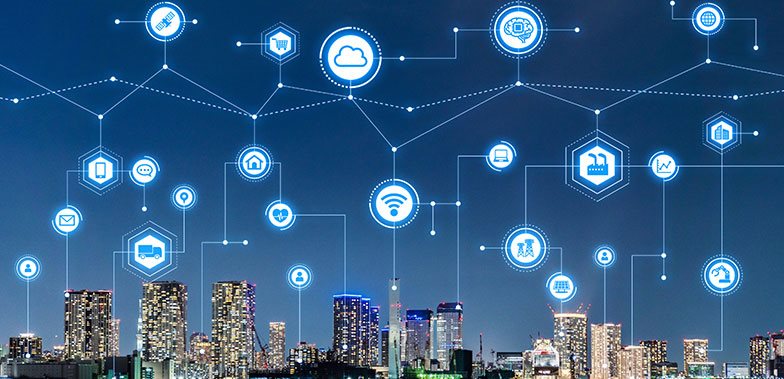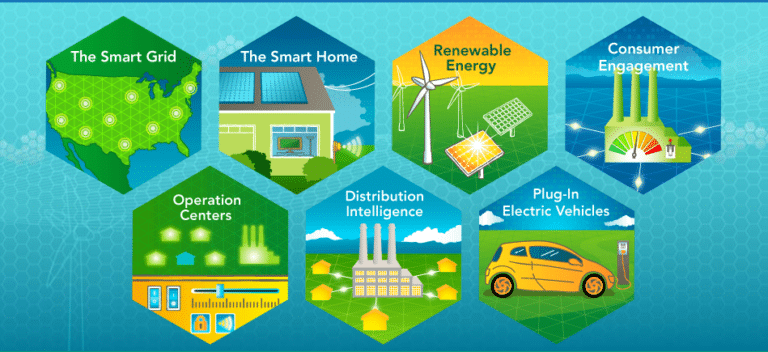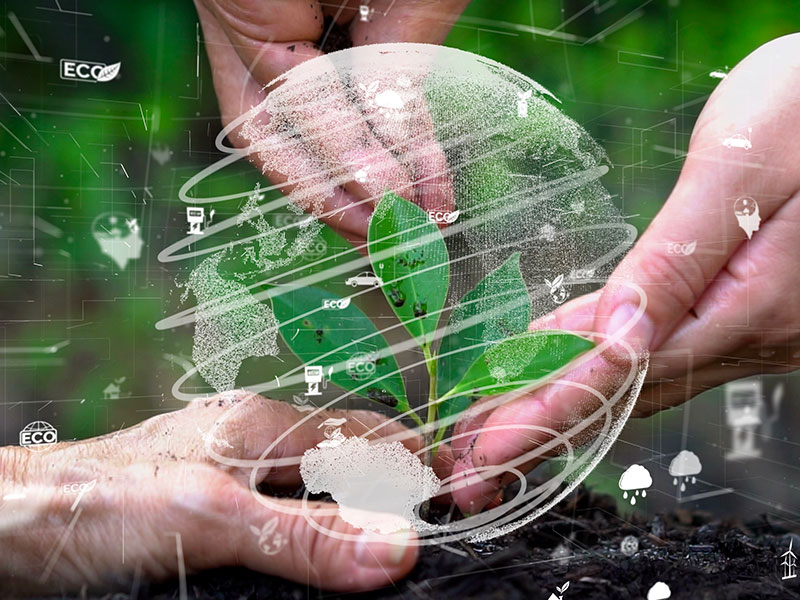What is a Smart City?
A smart city is a city that improves on efficiency of how a city runs, their communication, and overall quality of life through the use of technology and other forms of analytics. Smart cities utilize a framework of information and technologies to create a healthy and organized infrastructure that will help the city function.
When smart cities are used efficiently and to its furthest capabilities, they can achieve many problems that the city leaders are attempting to solve. Some of these achievements that smart cities can create is making an infrastructure based around technology, creating and executing environmental initiatives, implementing an effective and functional system for public transportation, and providing a community for people to be able to live and work within the same city. Through the use effective data collection, smart cities will be able to continue and thrive as time progresses.
What is Smart Energy and Environment?
My topic that I will be focusing on is smart energy and environment. In order to break this down I will discuss both smart energy and smart environment separately to get a clearer definition of the two of them, and then talk about how both of these interact with each other.
Let’s first begin by discussing smart energy. Smart energy is the use of optimizing energy costs and efficiency through the use of intelligent technology in order to build and operate a sustainable energy management system. Smart energy can be accomplished through the use of artificial intelligence, machine learning, data analytics, and IoT sensors to achieve certain issues that are at hand
Next is smart environment, and this is using technology such as sensors, displays, and computing devices that help the user get a better understanding of how to successfully control the environment. By being able to easily collect data about the environment, we will be able to seamlessly engage and interact with it, which is needed in the future.
Smart energy and smart environment go hand in hand with each other as the progress created through smart energy can then help improve the environment. Smart energy incorporates the use of alternative energy sources such as wind, solar, and hydraulic power to create cleaner forms of energy. By increasing the efficient in the energy it will be simultaneously be increasing the negative environmental impact, which is a problem that must be stopped before it gets to an irreversible point.
1. Dubai Clean Energy Strategy 2050. Dubai, UAE
The first example of smart energy being used around the world is present in probably the most recognizable smart city: Dubai. In 2015, Sheikh Mohammed launched the Dubai Clean Energy Strategy, which is a plan to make Dubai a global center of both clean energy and green economy. This plan has Dubai producing 75% of its energy through the means of clean resources by the year 2050.
This strategy is being achieved by breaking down the project into five main pillars: infrastructure, legislation, funding, building capacities and skills, and environment friendly energy mix. The pillars aim to support the city’s vision to become a global leader in sustainability, and also to enhance its economic growth and improve the well-being of its residents. With infrastructure, Mohammed Bin Rashid Al Maktoum Solar Park was created, which is the largest generator of solar energy in the world. Legislation includes creating a legislative structure that supports clean energy. For funding, UAE has pledged $30 billion towards the clean energy sector.
One of the key aspects of the Clean Energy Strategy is to increase the share of renewable energy sources in Dubai’s energy mix. Dubai has set a target to generate 25% of its electricity from solar energy by 2030. In support of this goal, Dubai has launched a number of renewable energy projects, including the Mohammed bin Rashid Al Maktoum Solar Park, which will be the largest single-site solar park in the world upon completion. The park is expected to generate 5,000 megawatts (MW) of clean energy by 2030, which will reduce carbon emissions by 6.5 million tonnes per year.
To complement its renewable energy and energy efficiency efforts, Dubai is also exploring carbon capture and storage (CCS) technology to reduce its carbon emissions. Dubai Carbon Centre of Excellence is currently conducting a feasibility study for a CCS project that would capture carbon emissions from the Jebel Ali power and desalination plant, which is the largest power plant in the city. If successful, the project could reduce carbon emissions by up to 2.5 million tons per year.
Dubai is also collaborating with international organizations and governments to share knowledge and expertise in the field of clean energy. In 2016, Dubai hosted the World Green Economy Summit, which brought together global leaders to discuss sustainable development and green growth. The city is also a member of the International Renewable Energy Agency (IRENA) and participates in international clean energy initiatives such as the Clean Energy Ministerial.
With these pillars being prioritized, they are able to efficiently achieve their goals. I believe that this is a great initiative put in place and I believe that it will be successful. Dubai has been at the forefront of achieving smart city feats so I trust that the officials will be able to make this happen. The biggest aspect that I like about this project is the timespan for it. Changing energy sources is a time consuming process so having the goal being 2050 is realistic for this to be accomplished.
2. Copenhagen’s Nordhavn Neighborhood. Copenhagen, Denmark
Copenhagen, the capital city of Denmark, is recognized as one of the world’s most sustainable cities, known for its bike-friendly streets, green spaces, and commitment to reducing carbon emissions. One of the city’s latest initiatives is the EnergyLab Nordhavn project, which is focused on transforming the Nordhavn neighborhood into a model for sustainable living. In this summary, we will take a closer look at EnergyLab Nordhavn and explore its potential for success.
EnergyLab Nordhavn is a partnership between the Municipality of Copenhagen, the Technical University of Denmark (DTU), and private sector partners such as energy and infrastructure companies. The project aims to demonstrate how a neighborhood can be powered by renewable energy, reduce its carbon footprint, and use data to optimize energy use. The project is being implemented in the Nordhavn neighborhood, a former industrial harbor area in Copenhagen that is currently being redeveloped as a sustainable, mixed-use neighborhood.
Key Features of EnergyLab Nordhavn:
- The EnergyLab Nordhavn project includes several innovative features that are designed to help reduce the carbon footprint of the neighborhood. These include:
- A district heating and cooling system: The neighborhood will be powered by a district heating and cooling system that will use seawater to provide heating and cooling to buildings. This will help reduce the energy required for heating and cooling and decrease carbon emissions.
- Renewable energy sources: The neighborhood will use renewable energy sources, such as wind and solar, to generate electricity.
- Energy optimization through data: The project will use data to optimize energy use, including data from sensors in buildings, weather forecasts, and energy market data. This will help ensure that energy is used efficiently and at the lowest possible cost.
- Electric vehicles: The project includes the use of electric vehicles and charging stations, which will help reduce emissions from transportation.
The EnergyLab Nordhavn project has the potential to be successful for several reasons. Firstly, Copenhagen has a long history of commitment to sustainability, and the project builds on the city’s existing infrastructure and expertise in renewable energy. Additionally, the project has received significant financial support from the EU’s Horizon 2020 program, demonstrating the EU’s confidence in the project’s potential. The project is also being implemented in a relatively small area, which makes it easier to test and refine the technology and infrastructure before scaling it up.

One potential challenge is that the project is dependent on the cooperation of private sector partners, and there may be financial or logistical barriers that could slow down the implementation of the project. Additionally, there may be technical challenges in implementing some of the innovative features of the project, such as the district heating and cooling system.
Overall, the EnergyLab Nordhavn project has the potential to be a success and serve as a model for sustainable urban development. The project builds on Copenhagen’s existing strengths in sustainability and has received significant financial support from the EU. However, there may be challenges that the project will face, and it will be important to monitor the project’s progress to assess its success. If successful, the EnergyLab Nordhavn project could demonstrate how sustainable urban development can help reduce carbon emissions and support a more sustainable future for cities around the world.
3. Amsterdam Smart City Program. Amsterdam, Netherlands
Amsterdam is known for being a city that is at the forefront of innovative urban planning and sustainable living. In recent years, the city has been focusing on developing a smart city program that uses technology to improve the quality of life for its residents and reduce its environmental impact. In this summary, we will take a closer look at Amsterdam’s smart city program and explore its potential for success.
Amsterdam’s smart city program is focused on developing technology solutions that can address the city’s most pressing challenges, such as traffic congestion, energy consumption, and waste management. The program is being developed in collaboration with both public and private partners, with the goal of creating a more connected and sustainable city.
Key Features of Amsterdam’s Smart City Program:
- The Internet of Things (IoT): Amsterdam is using IoT sensors to collect data on a wide range of factors that affect daily life in the city, such as traffic flow, air quality, and waste collection. This data is being used to develop new technologies and strategies that can help address these issues.
- Electric Vehicles: Amsterdam has been promoting the use of electric vehicles in the city by building charging stations, offering tax incentives, and developing policies to encourage their use. This is part of the city’s overall goal to reduce carbon emissions and improve air quality.
- Smart Grid: Amsterdam is developing a smart grid that will allow for more efficient and sustainable energy use. The grid will be able to integrate renewable energy sources, such as wind and solar power, and will help to reduce energy waste.
- Citizen Engagement: Amsterdam’s smart city program places a strong emphasis on citizen engagement, with the goal of involving residents in the development and implementation of new technologies and strategies. This helps to ensure that the solutions being developed are relevant and useful to the people who live in the city.
Amsterdam’s smart city program has the potential to be successful for several reasons. Firstly, the city has a strong track record of innovation and sustainable development, with a long history of promoting cycling, reducing carbon emissions, and preserving green spaces. Additionally, the program is being developed in close collaboration with both public and private partners, which means that it has access to a wide range of resources and expertise.
There are also some challenges that the program may face. One potential challenge is that the development of new technologies and strategies can be costly and time-consuming, and there is always a risk that these solutions will not be successful. Additionally, the program is still in its early stages, and it may take some time before the full benefits of the program are realized.
The program is being developed in collaboration with a wide range of partners, which gives it access to a wealth of resources and expertise. Additionally, the program is focused on addressing some of the most pressing challenges facing the city, such as traffic congestion, energy consumption, and waste management. However, there may be challenges that the program will face, such as the development of new technologies and strategies, and it will be important to monitor the program’s progress over time to assess its success. If successful, Amsterdam’s smart city program could help to improve the quality of life for residents and reduce the environmental impact of the city, while also inspiring other cities around the world to adopt similar approaches to sustainable urban development.
Sources:
https://u.ae/en/about-the-uae/strategies-initiatives-and-awards/strategies-plans-and-visions/environment-and-energy/dubai-clean-energy-strategy#:~:text=In%20November%202015%2C%20Sheikh%20Mohammed,clean%20energy%20and%20green%20economy.
https://galooli.com/glossary/what-is-smart-energy/#:~:text=Smart%20energy%20is%20the%20intelligent,into%20processes%20using%20IoT%20sensors.
https://www.sciencedirect.com/topics/engineering/smart-environment
https://www.igi-global.com/dictionary/smart-environment/27178
https://www.twi-global.com/technical-knowledge/faqs/what-is-a-smart-city
https://www.c40knowledgehub.org/s/article/Cities100-Copenhagen-s-new-Nordhavn-neighbourhood-is-a-centre-of-innovation-for-smart-energy-systems?language=en_US
https://sustainabilitymag.com/top10/top-10-smart-cities-around-the-world
Leave a Reply